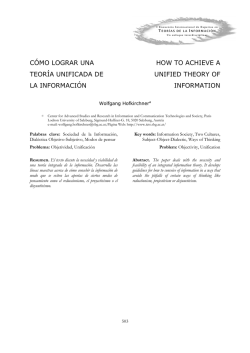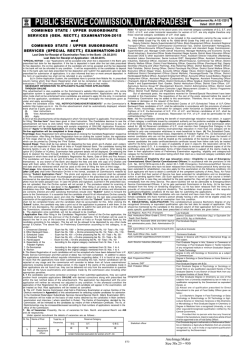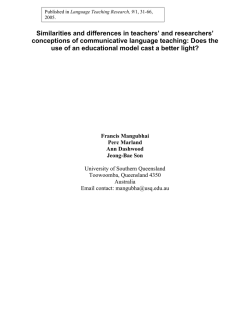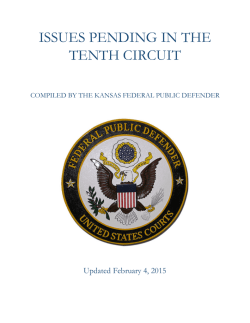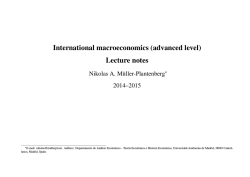
PROFIT MAXIMIZATION THEORY, SURVIVAL
Hotmal Jafar, Iskandar Muda, Andri Zainal, Wahidin Yasin: Pengaruh Penerapan Total Quality PROFIT MAXIMIZATION THEORY, SURVIVAL-BASED THEORY AND CONTINGENCY THEORY : A REVIEW ON SEVERAL UNDERLYING RESEARCH THEORIES of CORPORATE TURNAROUND Tengku Mohammad Chairal Abdullah Dosen Dept. Akuntansi FE USU Abstrak : Perkembangan sastra di bidang turnaround perusahaan telah berkembang pesat selama beberapa dekade terakhir. Namun ada beberapa argumen di antara para ulama turnaround perusahaan yang penelitian tentang bidang ini telah kurang dalam berhubungan dengan teori-teori yang relevan. Tujuan makalah ini adalah untuk menjelaskan beberapa di beberapa teori yang berkaitan dengan manajemen strategis yang mungkin juga berlaku di bidang perubahan haluan perusahaan. Beberapa teori, yaitu teori maksimalisasi laba, teori kelangsungan hidup berbasis dan teori kontingensi dibahas di koran. Asal-usul dan perkembangan teori masingmasing juga dibahas, bersama dengan beberapa ulama yang dipelopori mereka. Laporan utama dari setiap teori juga disajikan pada akhir diskusi teori masingmasing. Disimpulkan bahwa setidaknya, teori maksimisasi keuntungan, kelangsungan hidup berbasis teori dan teori kontingensi yang cukup relevan dengan perubahan haluan perusahaan. Oleh karena itu, dianjurkan bahwa ulama harus lebih berupaya dalam mengeksplorasi teori-teori lain dari manajemen strategis yang mungkin memiliki relevansi untuk mengubah perusahaan sekitar. Kata kunci: Corporate turnaround, manajemen turnaround, teori manajemen INTRODUCTION Body of literature on corporate turn around has been developing rigorously for the past three decades, both qualitatively and quantitatively. Even though most of the researches were emphasized more towards the qualitative research, the quantitative side of the research, though quite limited, still can be considered to contribute quite significant to the field. However there were some arguments among the scholars of this field that such research on corporate turnaround was lacking in relating the current research to the relevant existing theories (Pandit, 2000). One of the reasons why it happened perhaps because many researches on corporate turnaround were also more on the content and not the process (Chowdury, 2002). The content approach of research in the field of corporate turnaround, as we know, usually try to explain corporate turnaround in terms of statistical relationships among variables, mainly between independent and dependent variables. While the process side of the research usually explains how is the journey of the firm moving away from the lifethreatening situation towards better financial 136 situation. Good theory would need both the content and also the process side of the research. And since the appreciation of the process side of the research on corporate turnaround were still can be considered as non-existent, not-emphasized or inadequate (Barker & Duhaime, 1997), this is somehow crippling the theory development on corporate turnaround, as argued by Chowdury (2002). However, lacking in theory development of the field does not necessarily mean that there is no theory to relate it with. Since corporate turnaround is one of the branch fields of knowledge of strategic management, it is quite logically to relate some of the theories applied in strategic management to the corporate turnaround. Theories relevant to corporate strategy can be divided into 2 main categories which are prescriptive and emergent (Lynch, 2000). Several theories which are included in the prescriptive theories such as: profit maximizing/ competition-based theories, resource-based theories, game-based theories and socio-cultural theories of strategy. Few other theories which can be included as Jurnal Ekonom, Vol. 13, No. 4 Oktober 2010 emergent theories of corporate strategies such as: survival-based theories, uncertaintybased theory and human-resource based theory of corporate strategy. In addition to those theories mentioned by Lynch, Khairuddin (2005) also added two more theories which relevant to strategic management, namely the agency theory and the contingency theory. Many of these theories mentioned above were based on economic theories since strategic management is considered to be an applied field of knowledge which based on other disciplines as well as economics and psychology (Jenkins, 2005). Underlying theory used in number of researches usually to develop a framework as basis in explaining the phenomena which is about to be explained. By using such theory, several variables were identified based on that particular underlying theory. By so doing, researchers also limit him/her self from trying to explain many more variables which are not related to the underlying theory. For example, institutional theory was used to explain corporate turnaround situation among overseas Chinese companies in East Asia (Bruton, Ahlstrom, & Wan, 2003). Pandit, (2000) also, in an attempt to give some recommendations on the scant literature on theories relating to corporate turnaround, suggested resource-based theory to be used in future research on the subject. Hence the next section will discuss several theories in relation to corporate turnaround. THE PROFIT-MAXIMIZATION THEORY OF THE FIRM According to Hornby (1995), Theories of the Firm can be classified into five major schools of thought, namely: Classical Profit Maximization, Managerial Theories, Behavioral Theories, The Structure-Conduct-Performance Paradigm, and The Transaction Cost Approach. The Classical Profit maximization theory or as some might also call it as The Neo-Classical economic theory of the firm could be traced back as early as Adam Smith’s writing in The Wealth of Nations (Lynch, 2000). As Adam Smith argued that every business person with his/ her own company (based on contractual duties to owners) would act in self-interest to maximize profit and by so doing increased the aggregate benefit of the society. This theory then received considerable attention from Alfred Mashall in his book Principles of Economics which published in 1890 (Hornby, 1995). Further contributions to the theory were also added by writings from Robinson (1933), Chamberlain (1933) and also Coase (1937). However at this stage, this theory still adopting the economic perspective in which the main premise stated that firms essentially try to maximize its profit by equating its marginal revenues with marginal cost. It was not until 1950s and 1960s that this theory received considerable attention from strategic management field through writers such as Igor Ansoff, Alfred Chandler and Alfred Sloan (Lynch, 2000). Ansoff (1989) in particular stated that “…a firm seeks its objectives through the medium of profit and, more specifically, through conversion of its resources into goods and/or services and then obtaining a return on these by selling them to customers...In this respect, survival of the firm depends on profit; unless profits are generated and used for generation of future profit and replacement of resources, the firm will eventually run down”. This theory again came to the spotlight during 1960s with the publication of book by Friedman (1962), which mark the beginning of long discussions on corporate social responsibility. However it was only in 1970 that the real statement of the theory were stated openly to the public by Friedman (1970), as he mentioned “In a freeenterprise, private-property system, a corporate executive is an employee of the owners of the business. He has direct responsibility to his employers. That responsibility is to conduct the business in accordance with their desires, which generally will be to make as much money as possible while conforming to the basic rules of the society, both those embodied in law and those embodied in ethical custom.” This statement by Friedman (1970) also marked the shifting of the theory perspective, in which profit maximization could only be the ultimate goal so long as the law and ethical custom allows it to do so. 137 Tengku Mohammad Chairal Abdullah: Profit Maximization Theory, Survival-Based Theory Apparently rules and regulations have changed dramatically for the last few decades. In United States for example, the Court of Law has adopted a view that corporate directors and officers have a fiduciary duty to maximize the long-run interest of the corporate stockholders (Hanks, 1996). And in some cases, such as in a change-of-control situation, the Court of Law permit corporate directors to also consider the other stakeholders of the firm (such as suppliers, customers, etc) beside stockholders in making decisions (Oswald, 1998). Hence the profit maximization theory no longer adopts short-termism and absolute in nature (pure form). The change of paradigm in this profit maximization theory of the firm was a result from decades of criticism spearheaded by the emergence of the Stakeholders Theory of the Firm, introduced initially by Freeman (1984). Over the years, critics on this theory mainly came from the field of corporate responsibility (Cragg, 2002; Lantos, 2001), but later also from other field such as strategic management (Goldenberg, 2000) and even corporate turnaround (Champlin, 1998). However, despite its critics, this theory is still so much applicable today especially in big firms. Microsoft was so much accused of trying to achieve its longrun objective of profit maximization by monopolizing the market (Shazly & Butts, 2002). Hornby (1995) also found that profit maximization was still top objective for top Scottish companies both in the short and long term and also both in time of boom or recession. In the field of corporate turnaround, British Airways was accused of reducing its cost significantly to maximize its profit at the expense of its employee’s health and safety (Boyd, 2001). However this theory did not find much of support in the literature of the small business enterprise (Greenbank, 2001). The basic premise of this theory in the field of strategic management is: “The strategies will be driven primarily (but not exclusively) by the objective of maximizing the organization’s profitability in the long run with the ultimate purpose of developing sustainable competitive advantage over the competitor” (Lynch, 2000). The application of this theory to the field of corporate 138 turnaround is pretty straight forward. The objective of turning around company is to change the company situation from bad to good or better. And the first option and perhaps the only option at that time, was to enhance the company’s profitability. This means that profit-maximization is the main or perhaps the only objective available for the turning around companies in order to survive. Hence this theory is related directly to the field of corporate turnaround, and should be considered in future research of the field. THE SURVIVAL-BASED THEORY This theory, as previous one, was also initially introduced in the field of economics. Researchers such as Schumpeter (1934), Alchian (1950), Harrod (1939) and Marshall (1949) were among the first who introduced the idea of evolutionary thinking and natural selection into the concept of economics. Hence it is not a surprise to find most common application of survival of the fittest theory found in economics, mainly being used to analyzed how firms thrive and compete in industries, and also to explain changes in economy (Nelson & Winter, 1982). The concept of survival-based theory or some might call it as “survival of the fittest’ theory was originally developed by Herbert Spencer (Miesing & Preble, 1985). It was him who synthesized Darwin’s theory of evolution and natural selection with Adam Smith’s invisible hands to come up with the idea of Social Darwinism. This theory, which was quite popular during late 19th and early 20th century, emphasized on the notion that by following the principle of nature, only the best and the fittest of competitors will win, which in the end would lead to the improvement of the social community as a whole. Social Darwinism assumed it is normal for the competition to behave in hedonistic ways to produce the fittest business, who survived and prospered by successfully adapting to its environment or become the most efficient and economic producer of all. Hence, ruthless business rivalry and unprincipled politics is acceptable under this assumption. Jurnal Ekonom, Vol. 13, No. 4 Oktober 2010 However, in the later part of 20th century, opponents to the view of Social Darwinism, called Neo-Darwinism slowly emerged. This concept of Neo-Darwinism, which contrary to the Social Darwinism, emphasized strongly on social solidarity as fundamental fact of evolution. It is assumed under this view that competition and cooperation are interconnected, and competition will force business to be more cooperative. Hence, virtues and values of doing good and ethical business, such as through friendship, trust, loyalty and cooperation were encourage in order to survive the competitive market (Klein, 2003). Social Darwinism and NeoDarwinism is actually recognized as one of the three mainstream Theories of Evolution (Depew & Weber, 1995). The other two mainstreams are Probability Theory and Complexity Theory. While Probability Theory still relates to the view of evolution, it introduced new concept called punctuated equilibrium. In this concept, the gradual consistent changes in the extended process of evolution intermittently disrupted by short surges of new life forms. In organization terms, this explained by fundamental transformation of drastic, radical, sporadic, brief and all encompassing change of organization’s routine activities covering most of organization’s facets, which sometimes necessary for the survival of organization itself (Tushman & Romanelli, 1985). Complexity Theory on the other hand, tried to explain how organized systems could spontaneously emerged from the chaotic systems. According to this view, complex adaptive system was started from individuals with simple rules and goals, which in the end created a self-organizing system and formation of complex organization. Example of this view is the self-organizing system of a flock of birds flying in organized but tight formation (Sammut-Bonnici & Wensley, 2002). The introduction of Evolutionary Theory into the field of organizational behavior was occurred during late 1970s and early 1980s by researchers such as Aldrich (1979) and Hannan & Freeman (1977). It was Aldrich (1979) who introduced an evolutionary model and focused on whether particular traits existed in such organization that were appropriate for particular environment. And it was Hannan & Freeman (1977), who introduced the concept of population ecology in organization. However, Evolutionary Theory is not without its critics. It was argued that even though the theory can explain how organizations adapted, it still can not explain why organizations behave in certain ways. It only can explain the predominance of the least foolish of fools as argued by Khalil (2000). Evolutionary Theory also had such an impact on strategic management (Murmann, Aldrich, Levinthal, & Winter, 2003). Perhaps one of the significant contribution to the field was written by Henderson, with his article “The Origin of Strategies” (Henderson, 1989). In this article, he argued that competition was existed long before strategy and even perhaps started with the beginning of life itself. Since life had to compete since the beginning of its lifetime, no exact same species would survive and persist together (Gause’s Principle). Hence he argued that in order to survive, companies had to differentiate itself from its competitors since the existence of the same two identical companies who serve identical purpose and customers were pointless and would end up in the demise of one of those company. The survival-based view in strategic management emphasized on the assumptions that in order to survive, organizations has to deploy strategies that should be focused on running very efficient operations and can respond rapidly to the changing of competitive environment (Khairuddin, 2005), since the one that survive is the one that is the fittest and most able to adapt to the environment. Mc Donald was argued as one of the success story which suit perfectly to the Darwinian survival of the fittest theory (Stillman, 2003). It was argued that the success story of Mc Donald was attributed to its ability to adapt high level of efficiency into the hurried place of modern life and efficient workplace. However, some of the proponents of this view argued that selecting a particular set of strategy would not be optimal. Instead, it is better to experiment with several strategies at once and let the process of natural selection choose the best strategy that adapts better to the environment (Lynch, 2000). This view put the survival- 139 Tengku Mohammad Chairal Abdullah: Profit Maximization Theory, Survival-Based Theory based theory into the typology of emergent theories of strategic management. The application of this theory in the field of corporate turnaround was also quite straight forward. An ailing company usually faces lots of problems simultaneously, such as financial difficulties, failing products, losing key personnel and many others. These were actually just signs that the company was not running efficiently. Turning around company usually characterized with underperforming sales and under-capacity in terms of factory output and overwhelming size in human resource department. These characteristics of inefficient organization could explain why such turning around companies usually layoff its workers, repositioning their products and selling off its under-capacity assets in order to strengthening their condition. It is actually the primary objective of such turning around company to make the organization run efficiently in order to better adapt to the environment, improving its profitability and to achieve the ultimate goal of surviving the competitive market in which it operates. As survival-based theory argued, if it is not adapting to the ever-changing environment and become efficient in it, it simply will not survive. Thus the one that really successfully turned-around is the one that operates efficiently and adapting successfully to its environment. THE CONTINGENCY THEORY Contingency theory has been one of the most influential theory applied in strategy and organizational studies (Hofer, 1975; Schoonhoven, 1981; Tosi and Slocum, 1984) and also the one, which widely adopted in strategic management (Khairuddin, 2005). According to a study by Miner (1984), contingency theory is the most nominated theory by scholars as important from other 110 organization theories. The original ideas of contingency theory came from organizational theory (Khairuddin, 2005). It was this theory that revamped the whole idea of classical universalistic management theory, which stated there is always one best way of doing things. This theory started to emerge during 1960s with such publications by Burns and Stalker (1961), Chandler (1962) and 140 Lawrence and Lorsch (1967). The basic paradigm of contingency theory is that organization seeks effectiveness by fitting characteristics of the organization with contingencies that reflect its situations (Donaldson, 2001). Early contingency theories argued that high performance is associated with the suitability of contingencies such as organizational size (see e.g. Child, 1975), technology level (see e.g. Gerwin, 1979), strategy (see e.g. Chandler, 1962) and also environment (see e.g. Hambrick, 1981) with types of organization structure that an organization chose. Changes in contingencies, such as size or strategy, would render the structure to be unfit with the organization and lead to lower performance. Hence, adjustment to the structure was needed to regain the fit condition, in which would lead to higher performance. These researches on contingencies and organization structure were later known as structural contingency theory. As any other theories, contingency theory is also not without its critics and controversies. Perhaps earlier critics on this theory came from Child (1972), in which he argued that structure was not entirely defined or determined by changes in contingencies. Aside from contingencies, strategic choice, which controlled by organizational decisionmakers, also played major role in choosing types of structure and also changes in contingencies that the organization decided to take. In this view, it was not necessarily contingencies that followed structure, but changes in structure could also lead to changes in contingencies (Child, 1972). This critic was later categorized by Donaldson (2001) as determinism versus choice-critique on contingency theory. In attempt to answer the critics on this theory, Donaldson (2001) has synthesized six controversies and three problems attributed to the traditional contingency theory before proposing the Neo-contingency theory or as he called it the Theory of Performance-Driven Change. Through the years, contingency theory has evolved to involved more than just four contingencies, and has covered many aspects of organizational research. For example, a research on gender diversity based on contingency approach by Dwyer, Jurnal Ekonom, Vol. 13, No. 4 Oktober 2010 Richard and Chadwick (2003), found that gender diversity in fact have an influence on organization’s outcome, with a conditional factor of cultural context and overall organizational context. Dwyer, Richard and Chadwick (2003), argued that a genderdiverse management group would have positive effects on growth-oriented firm in a culture that values innovation, flexibility and interaction with the environment. In a research using contingency approach on remuneration policies on 2 UK utilities companies, Bender (2003) found that the remuneration policies of directors were clearly influenced by the choice of corporate strategies pursued by each company. While in another research on compensation for workers, Marler, Milkovich & Yanadori (2002) found that higher performing organizations pay higher incentives for their workers than lower performing organization, even though the higher performing organization pay less variable pay at lower levels compared with the lower performing organization. And in terms of size, they also found that larger organizations substitute greater supervision for incentive pay at lower levels in the organization, and used less variable compensation at lower levels than smaller organization. In an article on Porter’s generic strategy based on contingency approach, Murray (1988) argued that the viability of each of Porter’s strategy tied to the presence of a number of environmental preconditions. Meaning to say, the viability of generic strategies would be influenced by the existence of some preconditions on the external factors. According to Miller (1988), which also supported by Kim and Lim (1988), differentiation strategy is more likely to create sustainable competitive advantage in dynamic environment, while cost leadership would be able to achieve competitive advantage in stable environment. Industry conditions would also influence the effect of whether one chosen strategy would produce greater competitive advantage compared to another. And changes in industry conditions would force the strategy to be re-evaluated and adjusted accordingly, as argued by Gilbert and Strebel (1988). In a study on strategic change in car industry, Gilbert and Strebel (1988) found that a switch from a strategy of differentiation to cost leadership occurs when a product, which previously considered as unique, has become generally accepted. On the contrary, a switch from a strategy of cost leadership to differentiation occurs when an existing product is reworked and tailored to be introduced in an entirely new market segment. It is quite interesting to know that contingency approach was even applied to not-for-profit organization. Katz, Batt and Keefe (2003), found that CWA (Communications Worker of America – a worker union organization), faced with continuous corporate restructuring, abandoned their strategies that considered to be no longer fit with the environment, but still continue and even enhanced those strategies that were still fit. Contingency theory was also found its ground in the research of organization decline. For example, Freeman and Hannan (1975) found that growth and decline would bring different effect on structural variables of organization. They found that the supportive components of organization tended to increase as organization grow but decreased less during decline, which behaved differently compared to the direct components of organization. Another research by Cameron, Kim and Whetten (1987) found that top-management responses were significantly affected by the presence of turbulence and not by decline, while organization-member responses were significantly affected by the presence of decline and not turbulence. As Donaldson (2001) put it, the basic premise of contingency theory was that the effect of one variable towards another depends on the contingent factor of some other third variable, which might be called as moderating variable. As can be seen from some articles mentioned earlier, for example on Porter’s generic strategies, those generic strategies were claimed to have positive effects on competitive advantage and performance, if some preconditions on external environment were presence. These preconditions on external environment become the moderating or contingent factor, which affecting the relationship between Porter’s generic strategies and performance. Thus, the main emphasis of the theory is that even for the same type of organization, and by using the same techniques and methods of 141 Tengku Mohammad Chairal Abdullah: Profit Maximization Theory, Survival-Based Theory strategic management, the outcome should be vary depending upon the situational variables that made up the internal environment of organization, as well as the dynamics of organization’s external environment (Khairuddin, 2005). In the field of corporate turnaround, even though the author has not came across any research done by using contingency perspective, the influence of contingency view was already felt even from the earlier research on the field. For example, Slatter (1984) argued that development of recovery strategies should be attuned in accordance with the particular cause of decline. Mix results from several researches on corporate turnaround (for example, Arogyaswamy & Masoud (1997) found that workforce retrenchment, which claimed by many researchers to significantly help improved condition of the turning around firm, were also found existence in non-successful turnaround firm), were perhaps caused by these contingent factor. Hence the application of contingency theory in turnaround research should be heavily considered for further research on the subject. CONCLUSION It is argued in the earlier section that the application of theory in the field of corporate turnaround were very scarce and limited. One of the reasons why this happened perhaps because not many researches on the process side were produced by scholars of the field, as argued by Chowdury (2002). However, from the previous section, one could see that actually at least there were few theories that could be related to corporate turnaround, and many of these were actually borrowed from the field of strategic management. It is argued that perhaps many more theories were related to corporate turnaround. Hence it is recommended that such theory should be explored much further in future studies of corporate turnaround. REFERENCES Alchian, A. A. 1950. Uncertainty, Evolution and Economic Theory. Journal of Political Economy, 58, 211-221 142 Aldrich, H. E. 1979. Organization and Environments. Engelwood Cliffs, NJ: Prentice Hall. Ansoff, Igor. 1989. Corporate Strategy. Hammondsworth : Penguin Arogyaswamy, K & Yasai-Ardekani, Masoud. 1997. Organizational Turnaround: Understanding the Role of Cutbacks, Efficiency Improvements and Investment in Technology. IEEE Transaction on Engineering Management, 44, pp. 3-11 Barker, V.L., Duhaime, I.M. 1997. Strategic Change in the Turnaround Process: Theory and Empirical Evidence. Strategic Management Journal, 18, 13-38 Bruton, G. D., Ahlstrom, D., & Wan, J. C. C. 2003. Turnaround in East Asian Firms: Evidence From Ethnic Overseas Chinese Communities. Strategic Management Journal, 24(6) Cameron, K.S., M.U. Kim & D.A. Whetten. 1987. Organizational Effects of Decline and Turbulence. Administrative Science Quarterly. 32, 222-240 Champlin, D. 1998. Toward an Ethics of Corporate Restructuring. International Journal of Social Economics, 25(9), 1353-1366. Chowdury, Shamsud D. 2002. Turnarounds: A Stage Theory Perspective. Canadian Journal of Administrative Science, 19(3), 249-266 Cragg, W. 2002. Business Ethics and Stakeholder Theory. Business Ethics Quarterly, 12(2), 113-142. Depew, D. J., & Weber, B. H. 1995. Darwinism Evolving: System Dynamics and the Genealogy of Natural Selection. Crambidge MA: MIT Press. Donaldson, Lex. 2001. The Contingency Theory of Organization. United Kingdom: SAGE Publication Inc. Dwyer, S., O.C. Richard & K. Chadwick. 2003. Gender Diversity in Management and Firm Performance: the Influence of Growth Orientation and Organizational Culture. Journal of Business Research 56, 1009-1019 Jurnal Ekonom, Vol. 13, No. 4 Oktober 2010 Gilbert, X., and P. Strebel. 1988. Strategies to Outpace the Competition. Journal of Business Strategy, 8, 28-36 Goldenberg, D. I. 2000. Shareholder Value Debunked. Strategy & Leadership, 3036 Greenbank, P. 2001. Objective Setting in the Micro-Business. International Journal of Entrepreneurial Behaviour & Research, 7(3), 108-127 Jenkins, W. 2005. Competing in Times of Evolution and Revolution. Management Decision, 43(1), 26-37 Katz, H.C., R. Batt & J.H. Keefe. 2003. The Revitalization of CWA: Integrating Collective Bargaining, Political Action and Organizing. Industrial and Labor Relations Review, 56(4), 573-589 Khairuddin, H. M. 2005. trategic Management. Singapore: Thomson Learning. Klein, S. 2003. The Natural Roots of Capitalism and Its Virtues and Values. Journal of Business Ethics, 45(4), 387. Lantos, G. P. 2001. The Boundaries of Strategic Corporate Responsibility. Journal of Consumer Marketing, 18(7), 595-632. Lynch, R. 2000. Corporate Strategy (2nd ed.): Prentice Hall. Marler, J.H., G.T. Milkovich & Y. Yanadori, .2002. Organization-Wide Broad – Based Incentives: Rational Theory and Evidence. Academy of Management. Proceedings Paper Murmann, J. P., Aldrich, H. E., Levinthal, D., & Winter, D. G. 2003. Evolutionary Thought in Management and Organization Theory at The Beginning of The New Millenium. Journal of Management Inquiry, 12(1), 22-40. Pandit, N. R. 2000. Some Recommendations for Improved Research on Corporate Turnaround. Management, 3(2), 31-56. Sammut-Bonnici, T.,& Wensley,R. 2002. Darwinism, Probability and Complexity: Market-Based Organizational Transformation and Change Explained Through The Theories of Evolution. International Journal of Management Reviews, 4(3), 291-315 Shazly, M. R. E., & Butts, R. J. 2002. In quest of Profits: Legal and Ethical Implications Facing Microsoft. International Journal of Social Economics, 29(5), 346-355. 143
© Copyright 2025

